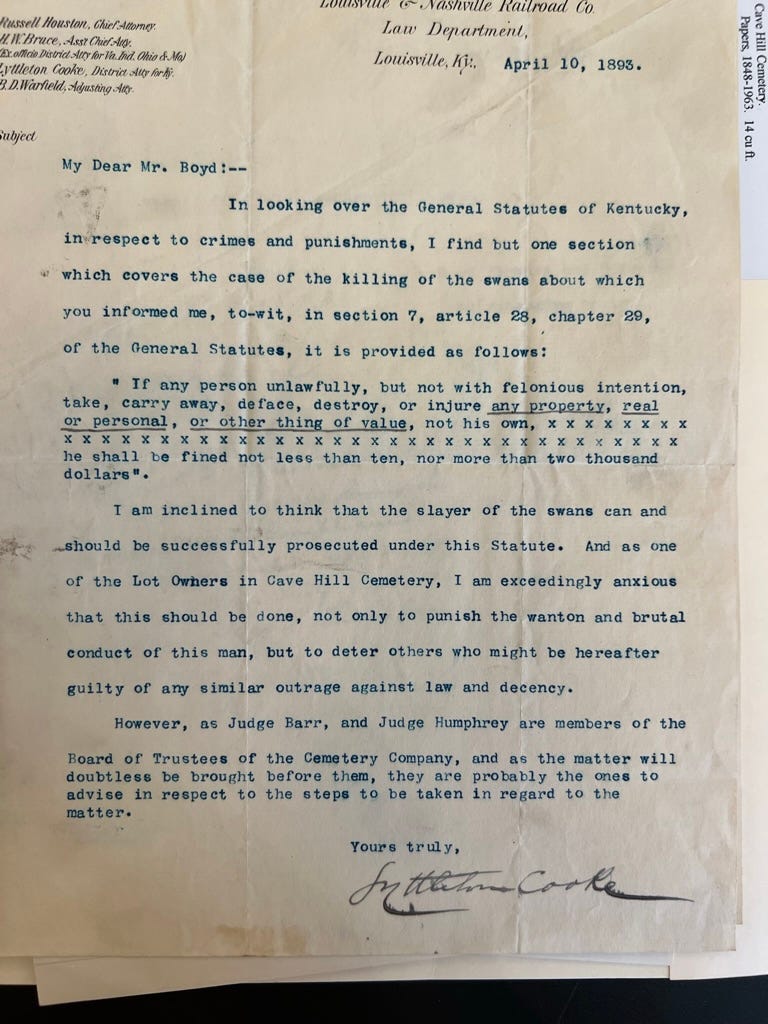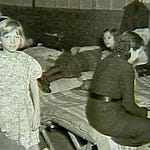WELCOME NEW SUBSCRIBERS!
Last summer I spent a couple of days in Louisville at the Filson Historical Society doing archival research on Cave Hill Cemetery.1 I have never done this kind of research before and the Filson staff patiently taught me the ins and outs of choosing boxes from its vast collection that might have artifacts that would shed light on burial regulations from the cemetery’s earliest days (1848-1900). This was of course the heart of the Victorian Era, and those Victorians had, ahem, “interesting” ideas about death. They were obsessed with elaborate mourning rituals, and creepy hair jewelry and hair art, as pictured below.


Americans at this time were also very particular about whose mouldering bones could lie in proximity underground. The cemetery’s 1879 rules, regulations and bylaws, which the Filson stored, specified that Cave Hill was established "for the white race exclusively" and provided that "colored persons, when admitted, must be accompanied by a lot-holder, or some member of the family of the lot-holder, or may be admitted by the written permit of a Manager..."



Interestingly, women were not allowed to enter the grounds unaccompanied because, hey, when you’ve got your foot on the neck of an entire race of people, why not put the other on women? They probably couched this rule in terms of female safety, or perhaps the feminine propensity to faint at the thought of death, or some other patriarchal subterfuge. I’m happy to report that a lot has changed since then. I have freely perambulated the grounds without an escort, and native son Muhammad Ali is buried there, along people of all ethnicities, religious affiliations, professions, and persuasions. I count this as progress.
One thing that hasn’t changed since its founding is the cemetery’s fondness for swans, which was also a Victorian obsession. It still features one in its logo today. This sent me digging around to figure out why. In this Smithsonian article, I learned that beginning in 1482 only English landowners of a certain income could keep them, and any bird found without a “swan mark” on its beak to denote its owner, was automatically the property of the crown. You could think of a swan mark like a cattle brand, but carved into the beak. According to the Smithsonian:
The prestige of swan ownership went far beyond their appeal as a delicacy. They were impressive enough as the centerpiece of a feast, but a swan in itself was not particularly expensive. The real desirability came from the right to own swans at all, because purchasing a swan mark was so expensive. To have a “game” of swans elegantly sculling around the lake of your stately pile required funds and status.
The rules relating to swans prevented ordinary people from interacting with them at all, beyond being able to see them on the river. If you weren’t an officially recognized swan keeper it was forbidden to sell swans, to drive them away from your land, to mark them or even to hunt with dogs or lay nets and traps on the river at certain times of year in case swans were injured.
Side note: here we have an economic lesson in how to drive up the price of something that doesn’t cost much at all.
Swan prestige traveled across the Atlantic like Victorian Christmas tree traditions. The Victorian influence on American culture likely can’t be overstated.
So, there I was in the Filson’s reading room, perusing a file of correspondence from the 1890s to and from Mr. J. G. A Boyd, who managed cemetery operations and was Secretary-Treasurer of the company. Among invoices and mundane requests for maintenance and landscaping, I continued to see letters from the W.A. Conklin Company of New York City, which, according to its fancy letterhead, traded in wild animals, managed zoological gardens, and supplied private menageries. I’ve since learned that William Conklin of the W.A. Conklin Company was Superintendent of the Central Park Menagerie from the 1860s through the 1880s.
Apparently, Boyd had written to Conklin about something befalling the Cave Hill swans, to which Conklin replied in his spidery hand: “Very sorry to hear of your misfortune with the swans. They were certainly a very nice lot. If you care to try again, will have some more while over this month, but am right out of the black…”2 He then went on to mention his current inventory of a white goose, a Brent goose, and a Rosybill duck, and claimed, “they will breed with any of the ordinary waterfowl.” Other letters discussed which swans would interbreed—it wasn’t often. Before going any further, check out Conklin’s letterhead!



Conklin’s swan inventory and sales price updates continued throughout 1893 and into ‘94. I was itching for resolution on this obviously important matter! What had happened to the swans! Were they replaced? If so, did the replacements survive?
Then, I came upon correspondence from Littleton Cook, District Attorney for Kentucky for the Louisville & Nashville Railroad Law Department that put the pieces together. It reads (emphasis mine):
In looking over the General Statutes of Kentucky, in respect to crimes and punishments, I find not one section which covers the case of the killing of the swans about which you in formed me, to-wit, in section 7, article 28, chapter 29, of the General Statutes, it is provided as follows…(see the picture below if this legal detail interests you).
I am inclined to think that the slayer of the swans can and should be successfully prosecuted under this Statute. And as one of the Lot Owners in Cave Hill Cemetery, I am exceedingly anxious that this should be done, not only to punish the wanton and brutal conduct of this man, but to deter others who might be hereafter guilty of any similar outrage against law and decency.
However, as Judge Barr, and Judge Humphrey are members of the Board of Trustees of the Cemetery Company, and as the matter will doubtless be brought before them, they are probably the ones to advise in respect to the steps to be taken in regard to the matter.
I don’t know if you read Cooke’s last paragraph as I do, but it would appear that Judges Barr and Humphrey should recuse themselves from any business coming before them from Cave Hill Cemetery. When it comes to judicial recusals, apparently some things never change right to the present day.
But wait! There’s more!
No sooner had I solved the mystery of the misfortunate swans did I come across another series of correspondence about stocking the cemetery’s ponds with black bass or crappie. Post haste! See pictured below two selected letters, first from Congressman Asher G. Caruth, who tried to intervene with the U.S. Commission of Fish and Fisheries to get Cave Hill a satisfactory delivery date for black bass and crappie. I’m cracking up just thinking about all these mustachioed men with their quill pens taking care of waterfowl and fish business.


On a more serious note, Cave Hill was one of the first rural cemeteries established in such a way that would protect it from being repurposed over time. In the words of Cave Hill’s dedication speaker in 1848:
It must be guarded from the rapacity of the buyers and sellers of another generation. If this complete security cannot be gained, nothing is accomplished and we must abide, as best we may, the mockery and dishonor attached to a spot which is the cemetery today, and which may be the shambles to-morrow.
…We adhere to the maxim, that the earth belongs to the living. That spot especially, to which we entrust the remains of our dead, belongs to us and to our children. It must not be given away; it must not be sold; it must not be taken from us…”
I hope you’ll take three minutes to enjoy this PBS affiliate video about Cave Hill. More than a final resting place, now it’s a community center and arboretum for the living—many a walker, jogger, and bird watcher enjoy its lovely grounds every day in addition to those who come to remember a loved one. The current management team has big plans for creating a dossier on everyone interred there, which, when the cemetery is filled, will be about 150,000 people.
I bet there are some fascinating Cave Hill stories in my readership. Please, dish!
It would make my day if you shared this story with someone who might enjoy it. Thanks in advance.
I’ll be back in a couple of weeks with July Trivia.
The Filson and Cave Hill have grown up together with Louisville, being founded in 1844 and 1848 respectively.
meaning black swans













